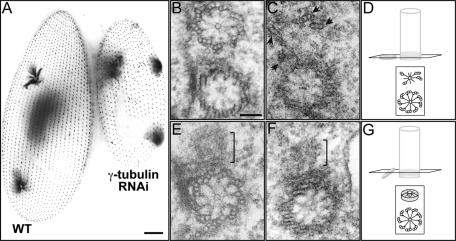FIGURE 7:
γ-Tubulin depletion results in the formation of daughter basal bodies that contain only cartwheels. (A) Control (left) and γ-tubulin–depleted (right) cells labeled with ID5 antibody. γ-Tubulin depletion leads to an inhibition of basal body duplication, as previously described (Ruiz et al., 1999). Bar = 10 μm. (B) Electron micrograph of a duplicating basal body in a control cell showing the mother (bottom) and daughter (top) cartwheels. (C, E, and F) Electron micrographs of γ-tubulin cells, fixed 48 h postsilencing. (C) The cross section passes through the cartwheel of mother and daughter basal bodies. In 42% of γ-tubulin–depleted cells (n = 24 in a total of 56 basal bodies analyzed), a cartwheel of reduced diameter could be identified. The structure of the new basal body is severely altered. Only 4 MT sets (triplets/doublets) are present (arrows). We detected MTs in only 2 out of the 24 basal bodies that contained a daughter cartwheel. (D) Schematic representation of the plane of section and (B). (E, F) The transverse sections passing through the cartwheel of the old basal body allow the visualization of a smaller daughter cartwheel (brackets). These cartwheels lack MTs. In these sections, the cartwheel is not completely tilted, as shown in the scheme in (G). Bar = 100 nm.

